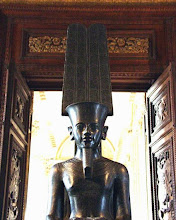The Curse of the Pharaohs
 Does the curse of the Pharaohs really exist? Or is it simply a case of illusion and stories spread by people? To answer this question, let us relate some stories of the curse. The Solar Boats were discovered in May 1954 while Kamal al Mallakh and Anis Mansour were having lunch at the Excelsior restaurant in the centre of the city [Cairo]. They received a phone call from Garceni who was responsible for removing the heaps of sand that covered the southern side of King Cheops' [the Great] Pyramid. As usual in archeological zones, the director was responsible for architectural works and removing the huge blocks of stone from the site.
Does the curse of the Pharaohs really exist? Or is it simply a case of illusion and stories spread by people? To answer this question, let us relate some stories of the curse. The Solar Boats were discovered in May 1954 while Kamal al Mallakh and Anis Mansour were having lunch at the Excelsior restaurant in the centre of the city [Cairo]. They received a phone call from Garceni who was responsible for removing the heaps of sand that covered the southern side of King Cheops' [the Great] Pyramid. As usual in archeological zones, the director was responsible for architectural works and removing the huge blocks of stone from the site.
The story began in 1944 during a visit by King Farouk and King Abdulaziz Al Saud to the pyramid in a royal horse and carriage. French archeologist Monsieur Drioton, the then director of the antiquities department, briefed them on the archeological zone. As the royal coach passed behind Cheops' pyramid, the Saudi monarch noticed a towering heap of sand and stones by the southern side of the pyramid and brought it to the attention of King Farouk, who directed Drioton to remove the mound. The antiquities department allocated 50 Egyptian Pounds for the operation. The removal of approximately 60,000 cubic meters of sand and stones exposed the remains of the archeological wall that surrounded the pyramid, which is part of the Great Pyramid's complex.
When the discovery took place, archeologist Zaki Nour, the then secretary of the site, was sick and absent from the scene. At that time, al Mallakh was a vigorous young man who had many friends in the press, especially the great writers Mohamed Hassanein Heikal and Anis Mansour, who is also a friend of mine.
Al Mallakh was a proud person and had a strong personality. Although the discovery was accidental, al Mallakh later said in his interviews and lectures that he had searched for the boats throughout his work in the area. When the phone rang in the Excelsior restaurant, al Mallakh jumped for joy and told his friends of the good news. They left their lunch and rushed to the pyramids, but on their way the car broke down and the engine caught fire. That was the beginning of the curse of the pharaohs for the Egyptians. King Cheops, it seems, did not leave al Mallakh alone and wanted more curses to afflict him. The news spread quickly about the discovery of Cheops's boats, which al Mallakh called the Solar Boats, which became the most important archeological discovery following that of Tutankhamen’s tomb on November 4, 1922.
At the same time, Zakaria Ghuneim discovered the incomplete [Step] Pyramid of King Sekhemkhet in Saqqara bringing Egypt to the center stage of the world. President Gamal Abdel Nasser and the men of the revolution accepted an invitation from Mohammed Hassanein Heikal and made an historical visit to the site of the new discovery demonstrating the revolution's respect for antiquities despite that there were reports that Abdel Nasser belittled the discovery, which seemed to be simply rumors that followed key events.
After that, newspapers asked Abdel Nasser to visit the discovery site of King Sekhemkhet's pyramid. At that time, Zakaria Ghuneim discovered a sealed coffin that was over 5,000 years old. When archeologists examined the coffin, they found that the ancient Egyptians sealed the sides with mortar, meaning that the last time this coffin was touched by a person was thousands of years ago. The entire world was shaken because the day that the coffin was to be opened would be memorable. Abdel Nasser and other men of the revolution were present and the international press came to see the coffin opened.
Archeologists prepared for the breath-taking moment that the coffin would finally be unlocked. It took place very slowly, with everyone waiting for the surprise. It was believed that the coffin contained the mummy of King Sekhemkhet, which would have made it the most significant discovery of all time, especially as the Step Pyramid had been built by Imhotep, the greatest genius of the Pharaonic age who had been idolized by the ancient Egyptians and glorified as the god of medicine. The intellects of ancient Egypt would say his name before they wrote on papyrus paper. The genius architect managed to build 7 kilometer-long underground pathways that accommodated a huge sarcophagus for the king and alabaster tombs to bury his eleven daughters. Only King Zoser's arm was found inside the pyramid and is now kept in the Cairo University's Faculty of Medicine. The finding of the sarcophagus was as significant an incident as al Mallakh's discovery of the Solar Boats. A small number of journalists were allowed into the burial chamber of the incomplete pyramid. Cameras focused on Zakaria Ghuneim's face as he opened the sarcophagus. Much to their surprise, the sarcophagus was empty of any Pharaonic secrets—it contained only the curse of the Pharaohs.
Source






